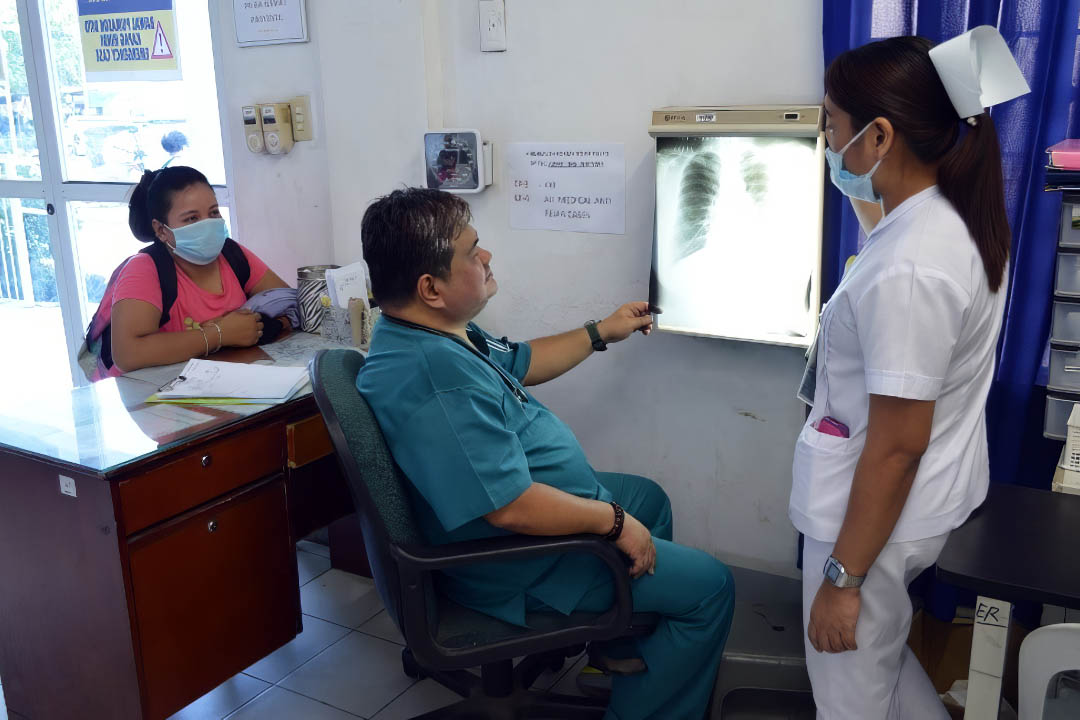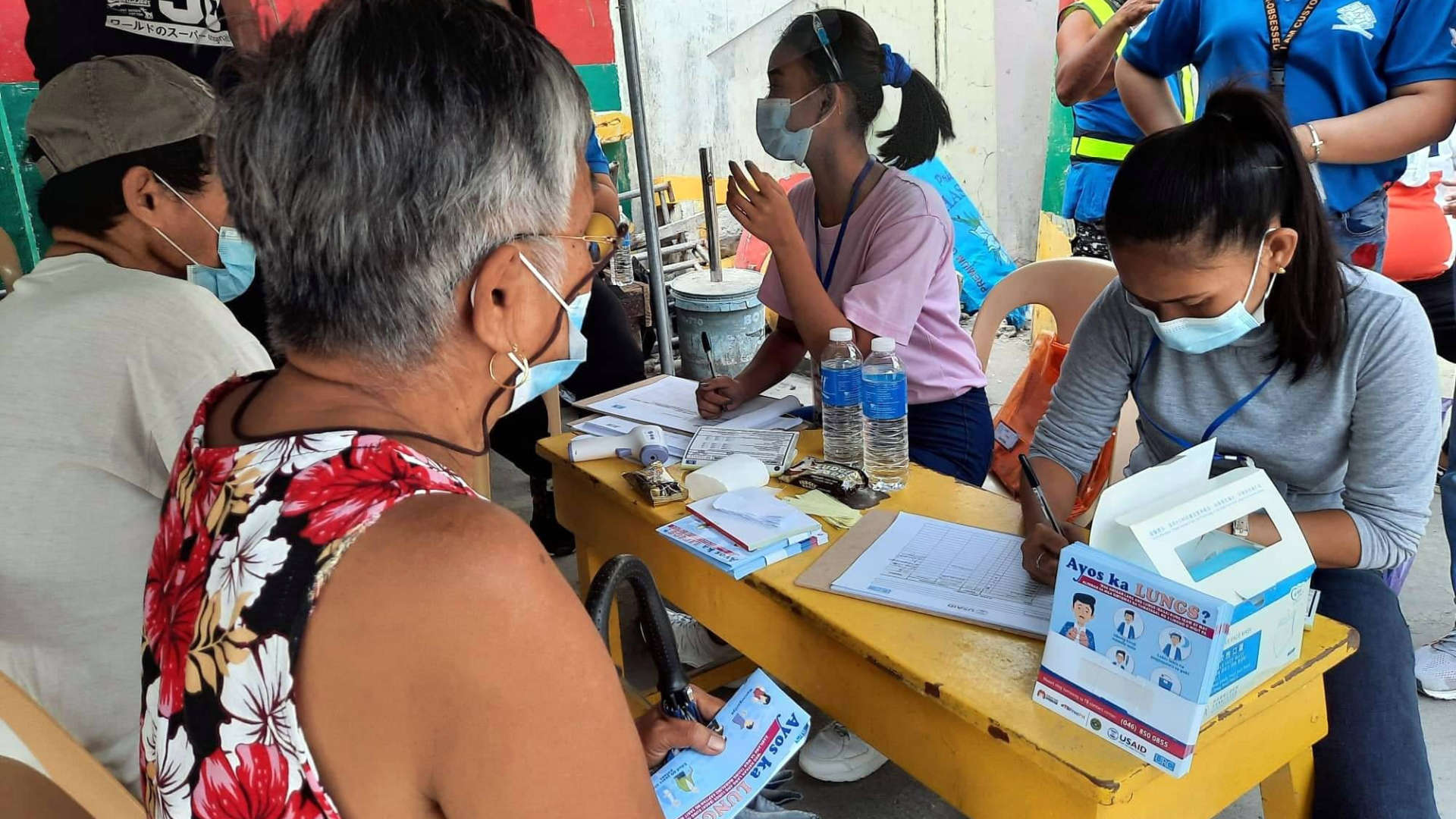Carlito, 28, is a humble furniture salesman from San Jose Del Monte City, in Bulacan Province, Philippines. He’s the father of two young girls with his partner, Jemelee. In late 2022, Jemelee noticed swollen lymph nodes on Carlito’s neck. Carlito never had experienced any TB signs or symptoms, but his lymph nodes kept getting larger.
Carlito went to the San Jose Del Monte City Health Center II (SJDM CHC II), which implements FASTPlus, a strategy to help healthcare workers proactively find missing tuberculosis (TB) patients during their first interaction with the healthcare system and enroll them to treatment. With the help of the FASTPlus strategy, Carlito received free TB screening and testing services.
Carlito was diagnosed with Drug-Sensitive Extrapulmonary TB (DSTB). Nurse Maria Cecilia P. Bunquin, the health center’s TB Program and FASTPlus Coordinator, immediately enrolled Carlito in treatment.
Upon hearing his diagnosis, Carlito felt shocked, almost to the point of disbelief.
“I could not believe that I have TB. I felt confused and kept thinking how I could have possibly contracted it,” he said. “However, I am grateful that I was finally diagnosed and put in treatment. It felt like I was being saved.”
What is The FASTPlus Strategy?
Carlito is one of 12,080 patients so far who have benefited from the FASTPlus strategy in SJDM City Health Center II, which began been implementing the strategy in April 2022. FASTPlus stands for Finding TB cases Actively, Separating safely, and Treating effectively.
FASTPlus is a focused TB transmission control strategy prioritizing rapid diagnosis and effective treatment. It has also successfully been used in countries such as Bangladesh and Vietnam.
In 2019, USAID’s TB Platforms – implemented by URC – adapted FASTPlus to the Philippine context, to help actively find and treat missing TB patients in the Big 3 regions – Regions 3, 4A and NCR – which account for 40% of TB cases in the country.
FASTPlus employs an active, screen-all approach for all patients seeking consultation in hospitals, rural health units (RHUs), and health centers, and those admitted to hospitals. The patients are screened for TB by symptoms, risk factor, and by chest x-ray. To increase the efficiency of screening at entry points, the screening process is integrated within the health facility’s triaging system.

How FASTPlus Strengthens Philippine Health Facility Networks
To implement FASTPlus, the TB Platforms team linked hospitals, health centers, RHUs, chest x-ray centers, with Rapid TB Diagnostic Laboratories or GeneXpert facilities and TB-DOTS centers to form a mini-service delivery network. This effectively provides TB patients with the services they need – including referral and feedback mechanisms – in the shortest time possible.
The project team also collaborates with partners, such as the Philippine Business for Social Progress (PBSP), through its Global Fund-supported ACCESS TB Project. PBSP is implementing a chest x-ray voucher program which provides patients – including those screened under FASTPlus – free chest x-ray services in contracted diagnostic laboratories. Another collaboration with PBSP ensures that all drug-resistant TB (DRTB) patients under FASTPlus receive free treatment at DRTB satellite centers.
TB Platforms also continuously collaborates with the Department of Health Regional Offices of NCR, CALABARZON, and Central Luzon, USAID’s TB Innovations, and the LGUs in supported sites, to ensure that FASTPlus is implemented effectively and efficiently.
Finding Thousands of Missing TB Cases
As of June 2023, the FASTPlus strategy is being implemented in 328 health facilities – including hospitals, RHUs, and health centers in 13 provinces and 16 cities/municipalities in the Big 3 regions.
The strategy has screened more than 5 million individuals for TB and provided them with TB health education. Of those screened, 3% (177,451) were identified as presumptive for TB either by symptom or chest x-ray. More than 71% (120,000) of the identified presumptive cases received free TB testing services.
Through FASTPlus, 81,173 missing TB patients have been found: 79,550 were DSTB and 1,653 were DRTB. Fifty two percent were bacteriologically confirmed while 48% were clinically diagnosed, and 63% were men and 37% women. Of all the cases, 91% (73,846) enrolled in treatment. The average turn-around time from screening to treatment decreased from a baseline of 7 days to 5.5 days in the facilities that implemented the strategy.
FASTPlus also has benefited healthcare workers. Nurse Maria – who has been working at SJDM CHC II for almost 26 years and is in-charge of implementing FASTPlus – said the strategy has helped her team to systematically find TB patients and enroll them in treatment.
“The screening process for TB has been redesigned and has therefore become more efficient,” Nurse Maria said. “Everyone is screened for TB and no one is exempted. We were able to find more TB patients and, in fact, we have surpassed our targets for TB treatment.”
On Treatment and Back to Work
By January 2023, Carlito had finished his first month of treatment. He remembers how scared he was when he was diagnosed with TB, especially for his 3- and 4-year-old daughters. “What if I transmit TB to them? What if I get so ill that I won’t be able to feed my family?”
Now he’s back at work and is not worried.
“I feel glad that I can already return to work after one month of treatment and put food on the table for my family,” Carlito said. “I am grateful for this second chance at living.”



